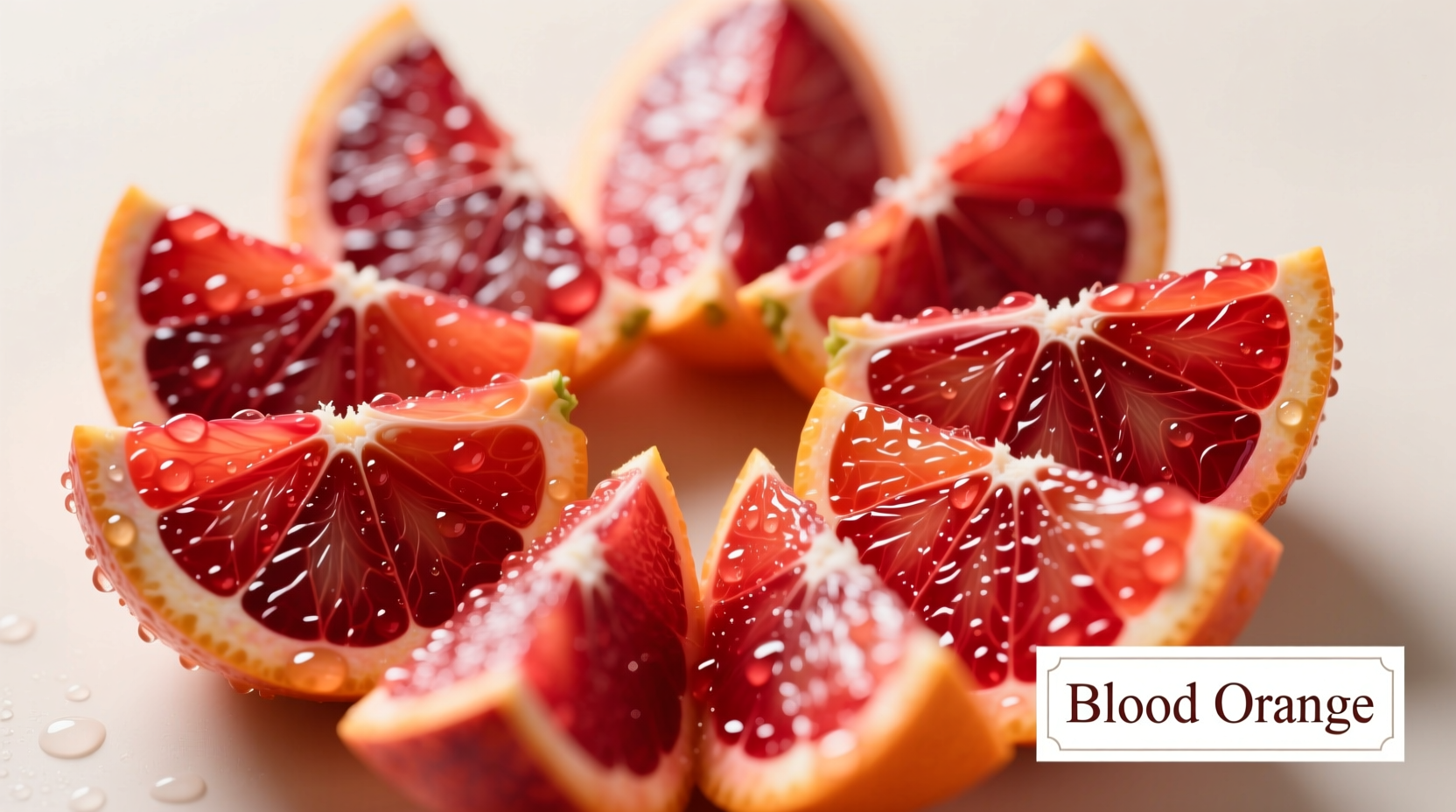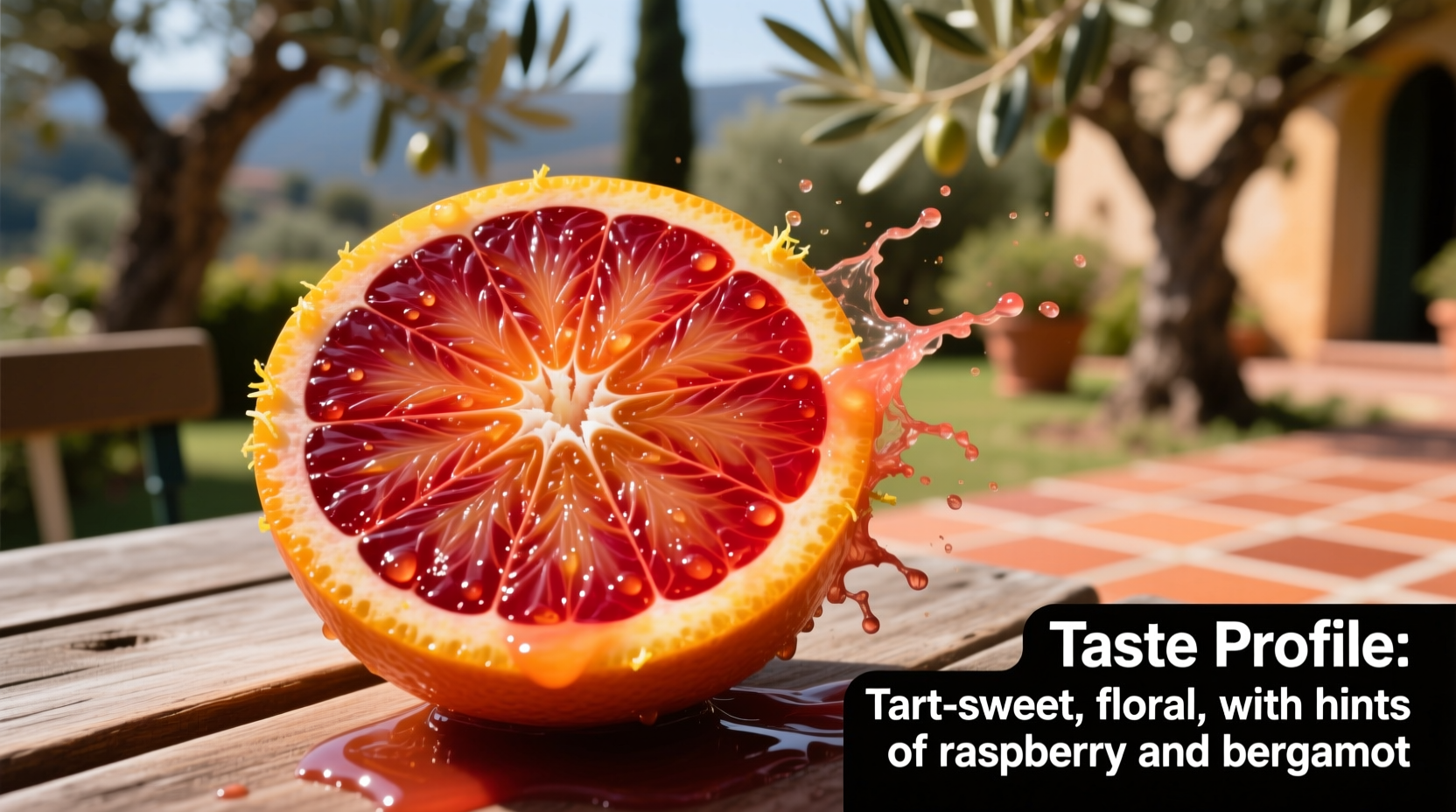Ever sliced into a blood orange and wondered why its deep crimson flesh promises a flavor experience unlike any regular orange? You're not alone. Home cooks and food enthusiasts frequently seek to understand this unique citrus variety's distinctive taste profile before incorporating it into recipes or purchasing it at the market. This comprehensive guide delivers exactly what you need: a precise breakdown of blood orange flavor characteristics, backed by culinary science and practical usage insights.
The Blood Orange Flavor Profile: What Sets It Apart
Blood oranges deliver a complex flavor experience that distinguishes them from their navel or Valencia cousins. While regular oranges primarily offer straightforward citrus sweetness with varying acidity levels, blood oranges introduce nuanced flavor dimensions:
- Berry-like undertones – Most noticeably raspberry or cranberry notes
- Reduced acidity – Approximately 15-20% less acidic than standard oranges
- Floral hints – Subtle aromatic qualities reminiscent of rose or hibiscus
- Deeper sweetness – More complex sugar profile with hints of honey
- Minimal bitterness – Significantly less bitter compounds in both flesh and pith
When you bite into a perfectly ripe blood orange, you'll first notice the familiar citrus burst, followed by those distinctive berry notes that develop as you chew. The aftertaste lingers with a pleasant floral quality that regular oranges simply don't provide.
| Flavor Characteristic | Blood Orange | Regular Orange |
|---|---|---|
| Sweetness Level | Complex, honey-like sweetness | Straightforward citrus sweetness |
| Acidity | Moderate (15-20% lower) | Higher, more pronounced |
| Distinctive Notes | Raspberry, cranberry, floral | Pure citrus, occasional grassy notes |
| Bitterness | Minimal | Noticeable in pith and membranes |
Why Blood Oranges Taste Different: The Science Behind the Flavor
The distinctive blood orange flavor stems primarily from anthocyanins—the same pigments that give berries their red, purple, and blue colors. Unlike regular oranges which lack these compounds, blood oranges develop anthocyanins when exposed to cool nighttime temperatures during ripening.
According to agricultural research from the University of California's Citrus Variety Collection, blood oranges require specific temperature fluctuations (warm days followed by cool nights below 59°F/15°C) to develop both their characteristic color and unique flavor compounds. This explains why blood oranges grown in Mediterranean climates like Sicily or California's Central Valley exhibit more pronounced flavor profiles than those grown in consistently warm regions.

Seasonal Flavor Variations: When Blood Oranges Taste Best
Blood oranges follow a distinct seasonal timeline that directly impacts their flavor quality:
- December-January – Early varieties (Sanguinello) begin appearing with mild flavor
- January-February – Peak season for Tarocco variety (sweetest flavor profile)
- February-March – Moro variety reaches optimal flavor with strongest berry notes
- April – Season ends with diminishing flavor complexity
Data from the USDA's Agricultural Marketing Service confirms that blood oranges harvested during peak season (January-March) contain up to 30% higher anthocyanin concentrations, directly correlating with more pronounced berry-like flavor notes. This seasonal variation explains why you might experience different taste profiles depending on when you purchase them.
Three Main Varieties and Their Flavor Differences
Not all blood oranges taste the same. The three primary varieties offer distinct flavor experiences:
- Moro – The most intensely colored with the strongest raspberry notes and slightly tart finish. Best for applications where bold flavor is desired.
- Tarocco – Sweeter and less acidic with delicate floral notes. Considered by many chefs to have the most balanced flavor profile.
- Sanguinello – Late-season variety with mild berry notes and exceptionally sweet profile. Often described as the "easiest" blood orange for those new to the variety.
Practical Applications: Using Blood Orange Flavor to Best Advantage
Understanding blood orange's unique flavor profile helps determine its best culinary applications. Unlike regular oranges that work well in both sweet and savory contexts, blood oranges excel in specific scenarios:
Best applications for blood orange flavor:
- Salads (especially with bitter greens like arugula)
- Desserts where berry notes complement other ingredients
- Cocktails requiring complex citrus notes
- Fresh applications rather than cooked (heat diminishes delicate berry notes)
Limited applications where blood orange flavor gets lost:
- Orange juice blends (berry notes become indistinct)
- Heavy baking applications
- Cooked sauces with strong competing flavors
This context boundary matters significantly—using blood oranges in applications that don't showcase their unique flavor profile represents a missed opportunity to experience what makes them special.
How to Select Blood Oranges for Optimal Flavor
Not all blood oranges deliver that prized flavor experience. Follow these selection guidelines:
- Choose heavier fruit for size (indicates juiciness)
- Look for deep crimson blush on the skin (correlates with anthocyanin development)
- Avoid fruit with green patches (may be underripe)
- Seasonal timing matters most—January through March offers peak flavor
Remember that blood oranges won't continue ripening after harvest like some fruits. What you buy is what you get in terms of sweetness development, though flavor complexity can mellow slightly when stored properly in the refrigerator for up to two weeks.
Blood Orange Flavor in Culinary Practice
Professional chefs leverage blood orange's unique flavor profile in specific ways that home cooks can easily replicate:
- Raw preparations – Sliced in salads, as garnish, or in fresh salsas where the berry notes remain pronounced
- Light cooking – Brief exposure to heat in compotes or reductions preserves some complexity
- Flavor pairing – Combines exceptionally well with ingredients that complement its berry notes: vanilla, honey, pistachios, and mild cheeses
Unlike regular oranges that work with virtually any flavor profile, blood oranges perform best when their distinctive characteristics are highlighted rather than masked. This understanding transforms how you approach recipes—treating blood oranges as a specialty ingredient rather than a simple orange substitute.
Common Flavor Misconceptions
Several myths persist about blood orange flavor that deserve clarification:
- Myth: Blood oranges taste significantly different based on their country of origin
Reality: While growing conditions affect intensity, the core flavor profile remains consistent across regions - Myth: The darker the flesh, the sweeter the orange
Reality: Color intensity correlates with anthocyanin concentration, not sweetness level - Myth: Blood oranges are always sweeter than regular oranges
Reality: They have more complex sweetness but similar Brix (sugar) levels to premium navels
Understanding these distinctions helps set accurate expectations when selecting and using blood oranges.
Conclusion: Embracing Blood Orange's Unique Flavor Profile
Blood oranges offer a distinctive flavor experience that elevates them beyond standard citrus options. Their complex profile—sweet citrus base with berry undertones, reduced acidity, and floral finish—makes them a specialty ingredient worth seeking during their winter season. By understanding what blood oranges taste like and how to select and use them properly, you can maximize their unique flavor potential in your culinary creations.











 浙公网安备
33010002000092号
浙公网安备
33010002000092号 浙B2-20120091-4
浙B2-20120091-4